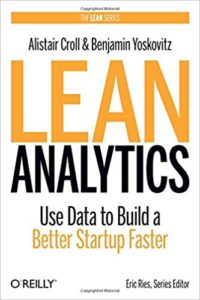 The book Lean Analytics by Alistair Croll and Benjamin Yoskovitz builds on the Lean Startup movement. The authors say that we live in a digital world, and we can build something on the cheap, measure its effect, and learn from it to build something better next time.
The book Lean Analytics by Alistair Croll and Benjamin Yoskovitz builds on the Lean Startup movement. The authors say that we live in a digital world, and we can build something on the cheap, measure its effect, and learn from it to build something better next time.
Lean Analytics is used to measure the progress, helping you to ask the most important questions and get clear answers quickly. In the book, the authors show you how to figure out your business model and your stage of growth. They further explain how to find the One Metric That Matters to you right now, and how to draw a line in the sand so you know where you stand.
Analytics is about tracking the metrics that are critical to your business, such as where your revenue comes from, how much you are spending, how many customers you have, and so on. In a startup, you don’t always know which metrics are key, because you are still trying to find the right product or the right target audience. Analytics can help you to navigate your way to the right product and market.
What makes a good metric?
In the book, the authors drive home the point that you need to measure what matters. There is no value in doing vanity metrics, for example counting how many users signed up, without taking that measure in context: how many users are also unsubscribing or how many of these users actually buy something or how many of these users become loyal customers, and so on.
The authors provide some rules of thumb for what makes a good metric. It must be:
- Comparative – we should be able to compare a metric to a competitor or to a different period of time or to different groups of customers
- Understandable – people must be able to discuss the metric and remember it
- Ratio or rate – a good metric is a ratio or a rate because it is inherently comparative
- Changes the way you behave – this is very important, because a metric should be able to guide you to do something differently
Finding the right metric
The book offers some proposed metrics that we can measure based on the type of business model that we choose. The major categories of business models are e-commerce type businesses, two-sided marketplaces that bring together users and providers of a certain service, software-as-a-service type of business, mobile apps and media such as blogs and news outlets.
For each type of business there are measures that we can track that make sense and show how well we are doing. These measures change with respect to the lifecycle where the company finds itself. For start-up business models, the authors use the following lifecycle stages: empathy (problem validation, solution validation), stickiness (creating a minimum viable product that engages), virality (growing adoption), revenue (convincing users to pay), scale (growing the company).
Metrics should be comparable, but in a startup, we may not know to what we should be comparing. How do we know what is the ideal value of a metric? Values depend on the stage that we are in. For example, we don’t want a too high growth rate too soon, while we are still building and refining the product. But we aim for a high growth rate in later stages. In the book, the authors provide some basic metrics, such as growth rate, visitor engagement, pricing targets, customer acquisition, virality, mailing list effectiveness, uptime, and time on site that apply to most business models. Additionally, they provide metrics specific to each of the business models.
Beyond startups
Finally, the authors offer advice on how to apply analytics in any company, not necessarily a startup. They say that you can turn analytics into a competitive advantage simply by asking good questions. According to the authors, the best thing you can do is pick a small but significant problem your company faces and work to improve it through analytics. They add a final word of warning: Metrics can be extremely valuable, but used incorrectly they’ll lead down the wrong path.
As a data professional, I find this book extremely informative with respect to what we measure, how we measure and especially why we measure. Many of the ideas in this book, especially those related to finding and measuring the proper metrics, apply to analytics in general.
